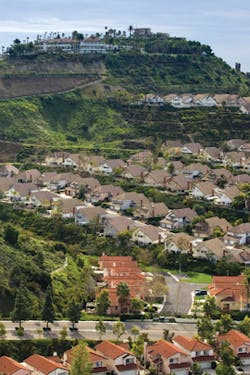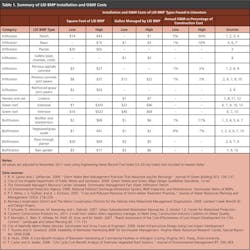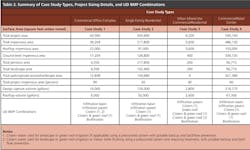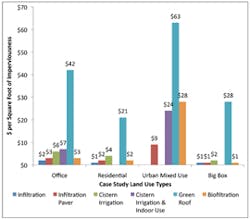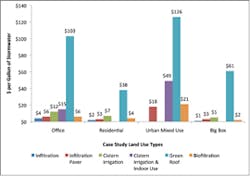The Costs of LID
With fourth-generation municipal separate storm sewer system (MS4) permits in California now requiring use of low-impact-development (LID) stormwater best management practices (BMPs) for discretionary new and redevelopment projects, the need for accurate LID BMP cost data has never been greater. Indeed, for development project proponents and the regulated MS4s, the data are fundamental both for informing the LID BMP selection process through technical and economic feasibility analysis, and for creating the basis of an appropriate mitigation or in-lieu fee in instances where a project proponent cannot meet runoff retention requirements entirely using LID BMPs onsite. To address this need, the County of Orange, on behalf of the Orange County Stormwater Program, partnered with the Construction Industry Coalition on Water Quality (CICWQ) to develop estimates of the costs of incorporating different combinations of LID BMPs into several of the most commonly encountered Orange County development scenarios.
In the case of California generally, LID BMPs are categorized as soil infiltration, rainfall harvest and use, evaporative, or biofiltration systems, and must be considered for application at a project scale in that hierarchical order. Technical feasibility for infiltration (e.g., infiltration rate, geotechnical conditions and concerns, presence or absence of pollutant plumes) is the principal analytical driver, followed by reliable demand for harvested water, in evaluating and selecting LID BMPs. In Orange County, green roofs are not required for evaluation in the LID BMP hierarchy, although they are considered a hydrologic source control and may be used to reduce a project’s runoff volume management obligation. Biofiltration and biotreatment type systems may be considered for use, but only after feasible application of infiltration or harvest and use practices. Economic feasibility of LID BMP implementation is also explicitly recognized in some MS4 permits, and is a required consideration in the application of the Clean Water Act’s maximum extent practicable standard in California.
The work presented here examines the installation and 20-year operation and maintenance (O&M) costs of installing LID BMPs using case study scenarios with design detail information provided by a number of different sources available to the cost-estimating team assembled. LID BMP cost information was also compiled through a literature review to enable comparison of the engineering cost estimates with other relevant work. Monetizable and non-monetizeable benefits derived from installing and using LID BMPs in the specific case studies analyzed are not examined in this article, but are the subject of a separate ongoing analysis that will combine installation, O&M, whole-life-cycle, and cost-benefit analysis.
Literature Reports of LID BMP Installation and O&M Costs
The literature review identified peer-reviewed journal articles, reports, guidance documents, literature reviews, and other publications that contained some type of information related to LID BMP costs. The literature found can be categorized into discussions of general LID BMP cost considerations, comparisons of LID BMP costs to those of traditional stormwater infrastructure (e.g., curb and gutter, catch basin inserts, and conventional treatment control), presentation of actual or hypothetical project cost data including the cost for O&M, and reports or discussions of LID BMP cost-benefit or whole-life-cycle cost analyses. A subset of the literature sources was then selected based on utility and comparability to the intent of the study reported here, data extracted and categorized, and then other smaller data subsets extracted according to data type on particular LID BMPs. Normalizing the data on a per-square-foot (of the LID BMP itself), per-square-foot of contributing impervious area, or per-gallon or per-cubic-foot-managed basis appears to produce the most useful expressions of LID BMP cost data and to be the most common measurements found in the literature, allowing comparison among LID BMP categories and types within categories.
Presentation of LID BMP capital installation costs collected from the literature are shown in Table 1, with the data sources reported between 2007 and 2011. LID BMP costs are categorized according to LID BMP type, and a low and high cost range is shown based either on the installation cost per square foot or per gallon of stormwater runoff managed. Costs reported in Table 1 were adjusted for inflation to 2011 US dollars using the 20-city Engineering News Record Construction Cost Index for Los Angeles, CA.
On an area basis (of the LID BMP), installation costs range from a low of $1 per square foot up to nearly $70 per square foot, except for green roofs. Infiltration and biofiltration BMPs are the least expensive BMPs to install and are reported to cost as little as $1 per square foot (nonproprietary biofiltration and swales). Infiltration BMPs including concrete pavers are somewhat more costly to install than biofiltration units, with trenches, curb-contained planters, and paver systems generally the most costly infiltration BMPs.
Expressed per gallon of runoff managed, infiltration and biofiltration BMPs are the least expensive LID BMPs to install, with per-gallon costs in the $1 to $5 range. Cistern costs reported in the literature range from a low of $1 to a high of $7 per gallon, with these systems serving outdoor irrigation demand only. There were no reports of runoff harvested for reuse serving indoor water demand such as toilet flushing or industrial process water. Extensive and intensive green roof systems are the most expensive LID BMPs to install, ranging from $7 to $325 per square foot and from $16 to $522 per gallon of runoff managed. In the two MS4 permits governing post-construction stormwater management in Orange County, green roofs are not required for consideration (although they can be used to meet the design capture volume (DCV) performance standard as a hydrologic source control), so detailed estimates are not provided here for individual case studies.
Each category of LID BMP has specific O&M requirements, although some common practices are necessary, such as physical inspection and reporting of results. Soil infiltration systems and biofiltration systems share common inspection protocols and reporting methods, and maintenance generally involves similar methods to examine surface conditions, measure soil permeability, and replace or augment infiltration or biofiltration media or biofiltration plant pallets. Permeable pavers are relatively simple systems, with predictable inspection and maintenance needs and practices using physical and mechanical practices. Harvest and use systems have different O&M requirements than those of soil infiltration, infiltration pavers, or biofiltration systems except for some common pretreatment intake inspection requirements to ensure solids removal. Harvest and use O&M requirements include inspection and potential repair of the cistern storage and delivery systems, mechanical and electrical systems controlling pumping and treatment, and the supply systems to outdoor and indoor uses. Harvest and use systems also require electricity for system operation.
Data in reports and literature documenting LID BMP O&M exist but are relatively sparse. We found several different reports, papers, or presentations that document per-project costs and generally include total project size, but the results were inconsistently reported and would have benefited from more data describing LID BMP geometry and sizing for cost normalization. Another technique used in the literature is to estimate annual O&M costs as a percentage of initial installation cost. In this regard, a small dataset is available and shown in Table 1. Annual O&M costs for surface-based LID BMPs range, in general, from 1% to 10% of initial construction costs.
Cost Estimating Methods and Assumptions
A case study approach was selected as a method for determining costs of installing, operating, and maintaining LID BMPs that meet the onsite DCV and treatment control standards specified in the north Orange County model water quality management plan (WQMP). The case studies are conceptual project development scenarios representing development types thought to most likely be constructed in Orange County. Data (property layout and design details) for conceptual case studies were supplied from several sources, including conceptual project design data used by the Orange County Public Works technical consultants to evaluate engineering feasibility scenarios (Orange County WQMP development stakeholder process); data from case studies used in a 2009 Geosyntec report titled “Low Impact Development Metrics in Stormwater Permitting”; plans and specifications for typical big box development scenarios provided by Near-Cal Corp.; parking layout and structure details provided by Choate Parking Consultants Inc.; design drawings and plans and specifications from CICWQ members; and vendors of LID BMP stormwater management products and systems including Contech Construction Products, Filterra Bioretention Systems, and Orco Block Company.
To assist in selecting case study types, a historical examination of approved water-quality management plans for priority projects in Orange County between 2006 and 2010 was combined with a consultative process among the CICWQ project team, county staff, and the county’s technical consultants (CDM and Geosyntec Consultants). Based on the results of the WQMP analysis and collaborative process, four case study types were selected for analysis and are shown along with relevant sizing data in Table 2.
For case studies 1, 2, and 4, assumptions were made that sufficient space for locating any type of LID BMP would be available within either the landscape or parking areas and that Orange County building codes would accommodate installing the LID BMPs as described. In general, infiltration or biofiltration systems were specified that use 2% to 3% of the total site area. Locating above or belowground cisterns on a project site uses less than 1% of the total area. Using some LID BMPs within an urban area is limited by building design and placement and use of existing infrastructure. Soil infiltration or nonproprietary biofiltration systems appear to be the most constrained LID BMP categories for use in urban areas, and this applies to case study 3.
The ability to locate any one or more LID BMPs within the total project footprint area was assumed to be unconstrained by infeasibility factors as defined in the north Orange County WQMP and technical guidance document (TGD). These factors include, but are not limited to, groundwater less than 5 feet below ground surface, geotechnical instability, pollutant plumes, and insufficient or competing demand for harvested or reclaimed water. Cistern BMP combinations described in the case studies assume that sufficient demand exists to fully drain the cistern within 72 hours of the cessation of stormwater runoff, either within the landscape or by indoor toilet flush use. Similar drawdown criteria applies to infiltration and biofiltration LID BMPs. Accordingly, demonstrating reliable demand for harvested water would have to be done in order for a cost comparison to biofiltration- or biotreatment-type LID BMPs to be relevant and meaningful. If harvested water demand does not exist, according to Orange County model WQMP requirements, then cisterns may be bypassed in favor of appropriately designed biofiltration or biotreatment systems.
Up to five different LID BMP types and configurations were selected to develop conceptual cost estimates of installation and the annual maintenance, operating, and inspection costs. These include infiltration basins, infiltration concrete pavers, cistern runoff collection for harvest and use, green roofs to intercept rooftop runoff, and biofiltration systems. Most MS4 permits in California use the 85th percentile, 24-hour rainfall event as the prescriptive standard for stormwater management using LID BMPs; this standard is also known as the design capture volume. For the case studies described here, a 0.85-inch rainfall event (also called the design storm) was used as the basis for determining the total DCV for a particular development scenario. Runoff generated by the design storm was converted to volume using the rational method.
The cost estimates developed for this study were prepared using labor costs based on the prevailing wages in Section 1773.2 of the California Board of Industrial Relations Labor Code. Material costs are based on building materials pricing in the Orange County area as of April 2011. The equipment cost rates are based on the 2010 edition of the “Blue Book” prepared by Blue Book International. A team of engineers, contractors, and vendors with appropriate construction and maintenance experience was used for estimating costs.
Results
The case studies examined four different development project scenarios ranging in size from a small urban mixed-use commercial retail and residential property with no parking provided (0.14 acre), up to a large “big-box” type commercial retail center on 12.4 acres. In three of the four scenarios, the percentage of impervious area assumed was 90%, with LID BMPs sited predominately within landscaping and parking areas. Five different LID BMPs were considered for application within the four hierarchical categories of LID BMPs: infiltration basins and concrete pavers, harvest and use cisterns, green roofs, and biofiltration systems. LID BMP total installation costs and O&M costs ranged from just over $50,000 for an infiltration paver system serving the small urban mixed-use residential and commercial scenario (0.14 acre, 2,800-gallon DCV) up to $4.7 million for a cistern and green roof combination serving the 12.4-acre big-box commercial project (Table 3).
To compare installation and O&M costs, data from all four case studies were normalized per square foot of contributing total impervious area (TIA), and per gallon of stormwater managed by the LID BMP. For all four case study scenarios, infiltration basins, infiltration pavers, or biofiltration systems are the least expensive LID BMP options to install and operate and maintain compared to cisterns and green roofs. Expressed per square foot of contributing TIA, installation and O&M costs are less than $10, and when the urban case study is excluded, costs are generally less than $3 (Figure 1). On a per-gallon basis, the capital cost of installation and O&M is less than $10 for all three types of BMPs (Figure 2), and when the urban example is excluded, cost drop to less than $3 per gallon.
Harvest and use systems and green roof systems cost at least twice as much to install as infiltration or biofiltration systems. Using cisterns to collect rooftop or surface runoff or both–either belowground or aboveground–is intermediate in capital cost among LID BMPs evaluated. The installation and O&M cost of cisterns ranges from $2 to $24 per square foot of TIA (Figure 1). On a per-gallon basis, cistern costs range from $5 in a large commercial project to $49 in an urban situation managing a low volume of runoff (Figure 2).
BMP configurations that use a green roof as a hydrologic source control to manage a portion of the DCV are the most expensive BMP systems on a capital installation cost basis. Expressed per square foot of TIA, green roof costs range from $10 to $79 (Figure 1) and range from more than $20 up to $130 per gallon (Figure 2). Unless a project is lot-line to lot-line, a green roof cannot manage the entire DCV alone compared to all other LID BMPs evaluated.
Another way to express and compare costs among LID BMP types is by using the per-square-foot installation cost of the BMPs
themselves (Table 4). The case studies show that infiltration basin systems range in cost from $19 to $63 per square foot, infiltration pavers range in cost from $8 to $28 per square foot, biofiltration systems range in cost from $29 to more than $100 per square foot in urban applications, and green roofs range in cost from $21 to $61 per square foot (Table 4). These costs do not reflect property value. Harvest and use systems are typically evaluated and compared volumetrically, so no per-square-foot installation and O&M costs were calculated.
Discussion
Assuming no technical infeasibility constraints, the least-cost LID BMPs are infiltration and biofiltration systems, regardless of volume managed or project type (Figures 1 and 2). Where space is available within a project site (the case studies assumed 3% or less of the total site area) to install an infiltration basin or biofiltration system, the cost of installing these two types of LID BMPs is under $4 per gallon and $2 per square foot of TIA. The analysis shows that infiltration systems are less expensive to install than biofiltration systems. The infiltration basin costs reflect the use of hydrodynamic separation units for pretreatment; biofiltration systems may be used as well for pretreatment, but they are more expensive, generally, than hydrodynamic separators. However, they can be used to provide a greater level of pretreatment than hydrodynamic separators for certain pollutants, such as metals and some nutrients.
There is a minimum cost to install infiltration or biofiltration systems, including the use of a pretreatment system (for surface runoff) and the provision for runoff discharge in excess of the DCV, including conveyance and connection to the MS4. Where hydraulic conductivity of the soil is less than 0.3 inch per hour and more expensive infiltration devices and media must be specified, or where some of the volume of runoff captured must be conveyed to the MS4 in underdrain or overflow systems, costs are still generally low compared to all other LID BMPs. Infiltration systems that involve placement of engineered pervious pipe sections (metal or metal-reinforced plastic) along with importation of porous rock media (also known as infiltration gallery systems) may add up to 20% to the material and labor costs to install, according to the estimators used for this project.
Biofiltration systems for case studies 1, 2, and 4 assume that soil amendment with engineered soil media is required and overflow/underflow conveyed to the MS4, and the capital cost of installation reflects this and results in costs greater than those for soil infiltration systems. Decentralization of infiltration or biofiltration systems within a given case study scenario may add as much as 10% of the capital cost of installation according to the estimators used for this project, resulting from additional equipment and labor mobilization within a given project footprint.
Similarly, if sufficient space is available within a project’s footprint to use permeable pavers (within low-speed access areas or surface parking areas), this type of soil infiltration system can manage runoff on a per-gallon basis as low as $3 and as much as $18 in the urban environment. For case study 3, which examines a small urban scenario, the small volume of runoff managed relative to the labor effort of installation and material required for DCV management using an infiltration paver system or biofiltration system is the principal reason the cost of installation per gallon and per square foot of TIA is more than two to four times greater than in the other case study examples.
Working in the urban footprint is more time consuming (labor hours) than in new development or some redevelopment, or where space limitations/utility conflicts do not exist. Mobilization of equipment and manpower is more expensive in the urban footprint than in greenfield situations or in larger redevelopment situations analogous to case study 1, for example. In addition, feasibility constraints are a driver of LID BMP choices within the LID BMP selection hierarchy, as fewer options are available in an urban setting for managing stormwater. Fewer options for management appear to result in increased system costs.
Harvest and use system costs–assuming reliable demand is present for stored water–are clearly higher than those for infiltration and biofiltration systems in all cases, but are in the same order of magnitude. Costs for installing a cistern and supporting equipment are two to six times more than for installing infiltration or biofiltration systems. This reflects the cost of the cistern materials and required connection and supply pumping/conveyance devices, and provision of an overflow device and piping to convey runoff that is not captured in the cistern to the MS4 (or to other LID BMPs). Where the potential exists to use harvested water indoors for toilet flushing demand, the cost of treating the water to nonpotable standards specific to California, meeting applicable code requirements for backflow prevention, and conveying this water within a building footprint add to installation cost. Cistern costs presented in this study are for the cistern system, including treatment costs, pumping, electrical controls, and a separate outdoor irrigation system. If the indoor demand projection for harvested water is justified, a separately plumbed water system to serve toilets costs at least an additional $2 per square foot of building area, according to mechanical estimators used for this study.
The maximum extent practicable (MEP) standard in California requires that LID BMP selection be based upon a number of criteria, including both effectiveness and cost. Because rainfall arrives in southern California in the months of November to April in a back-to-back-to-back successive pattern on a daily time scale, it is necessary to consider drawdown times (for infiltration) or reliable harvested water demand (for cisterns) when selecting and designing LID BMPs. (Drawdown time design guidance ranges from 48 to 96 hours.) Sufficient capacity to accept the DCV must be maintained in one or more LID retention BMPs for a site, or rainfall runoff will bypass the LID BMP and discharge directly into the MS4 without any treatment. While a biofiltration LID BMP may not retain 100% of the DCV, it can be designed to provide greater annual runoff volume treatment because it can manage a larger runoff volume and regenerate capacity more quickly than a cistern system, for example.
Conclusions
This study evaluated five different types of LID BMPs for application in Orange County, CA, land development projects using a case study approach. Data developed showed that infiltration and biofiltration systems were the least-cost practice to manage the DCV for a given project, and the least costly BMPs to operate and maintain over a 20-year period. This finding is generally consistent with a small amount of published literature and reports on LID BMP costs in the US.
Biofiltration systems are more costly to install and operate than infiltration systems because of the requirement for specialized soil media and amendments, plant pallets, and infrastructure to convey runoff greater than the DCV to the MS4. Cistern systems and green roofs are more costly to install, operate, and maintain, with costs at least double those of infiltration and biofiltration. Literature on cistern costs, and especially cistern operation and maintenance, are scarce, while data in the literature on green roof costs are more prevalent than those for cisterns.
This study addresses some of the data gaps concerning LID BMP installation and O&M costs, and may be used to support stormwater management decision-making processes. One of the primary uses of this work is to help inform when the relative cost of installing a 100% DCV LID BMP is not commensurate with its ability to manage the DCV compared to other LID BMPs in the hierarchy of options prescribed in MS4 permits. This study and the literature review have demonstrated that biofiltration LID BMPs are significantly lower in cost to install and maintain than cistern systems. Consequently, when retention of all or a portion of the DCV cannot be managed using an onsite soil infiltration system, a project designer will be faced with the choice of evaluating a harvest and use system versus a biofiltration-or biotreatment-type LID BMP system, which by design filters and treats some of the stormwater that is not infiltrated or evaporated before it is discharged to the MS4. The application of the MEP standard as it has been expressed in California appears, on the basis of this work, to create a different LID BMP hierarchy to the one currently being specified in California’s Phase I MS4 permits.
Most fourth-generation MS4 permits in California provide a mitigation or in-lieu alternative to project proponents. Therefore, a second application of this work will be in the establishment of an appropriate mitigation or in-lieu fee for the volume of runoff that cannot be managed by any combination of onsite LID BMPs. The possible basis for a charge could be expressed using normalized metrics introduced in this study, such as per gallon of runoff managed or per unit area of contributing impervious surface. However, these are relatively simplified approaches, and a mitigation system may involve other quantifiable factors such as the potential for pollutant generation from various land uses and location-specific stormwater management needs.